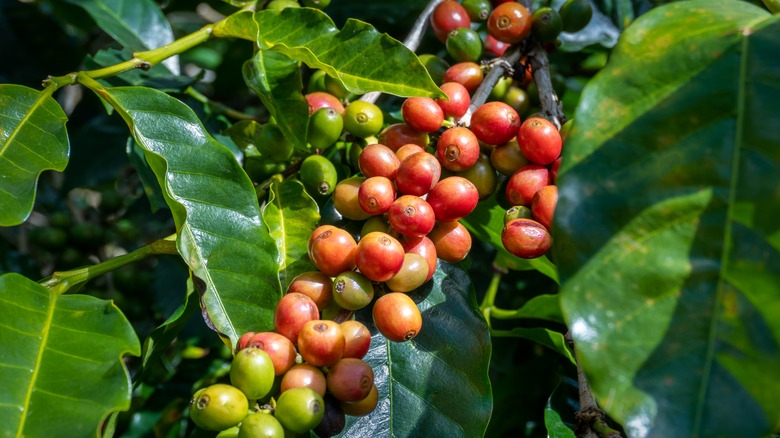What Makes Costa Rica's Coffee So Special
Trying to explain what's special about coffee in Costa Rica is a difficult endeavor. Nearly everything about this Central American country's coffee production is notably unique, from its high altitude farms blessed by heavy rainfall and fertile volcanic soils, to its multiple yearly harvests, pioneering processing methods, and artisanal café culture.
Coffee growing came to Costa Rica by way of Cuba in 1779, according to The Tico Times, and by 1820 its rapid growth was fueling profitable exports to regional neighbors. Today, Costa Rica by law grows only 100% Arabica coffee beans, per Café Britt, and these types of beans are perfectly suited to the country's climate and geography. Arabica beens thrive on high altitudes and warm temperatures, both of which Costa Rica has in abundance. Temperatures are ideal year round, during both the dry and rainy seasons, and the often volcanic soils are so fertile that Costa Rica is able to harvest coffee a remarkable three times per year (via The Tico Times).
Costa Rica's eight coffee growing regions all boast distinct microclimates and growing conditions, and thus produce coffees with unique flavor profiles and aromas. Tarrazú is perhaps the best known of these growing regions, thanks to its consistently high-quality coffees produced from mountainous, high-altitude farms situated between 1,200 and 1,700 meters, per Espresso & Coffee Guide.
Costa Rica's contributions to the coffee industry
Volcanic soils are often rich in mineral nutrients such as phosphorus, potassium, and calcium, all of which, according to Perfect Daily Grind, have been shown to produce better flavors and aromas in coffee. It's not just Costa Rica's fertile soils that set it apart, however. Innovative processing methods are likewise a key contributor.
As the National Coffee Association observes, Costa Rica is known for wet-processing. This means that as soon as coffee fruit are harvested — they're hand-picked in Costa Rica, notes Café Britt – the skin and pulp are water washed from the cherry before its seeds (aka beans) are dried and roasted. (via Espresso & Coffee Guide) But Costa Rica, always inventive, has also pioneered a hybrid "honey method" which allows producers to choose the level of mucilage, or "stickiness," left on their beans. This mucilage level has a direct effect on the sweetness and body of the finished coffee, confirms Origin Coffee.
The result, points out Driven Coffee Roasters, are coffees notable for their light body; bright, lively acidity; and rich, aromatic flavors. Of course in Costa Rica, brewing isn't conventional either. The country also invented the chorreador, a wooden or metal stand which holds a cloth filter (called a bolsita) that's filled with coffee grounds. Hot water is then poured through the coffee-filled filter into a waiting cup, per Perfect Daily Grind. It's distinctive and delicious, just like virtually everything having to do with coffee in Costa Rica.

